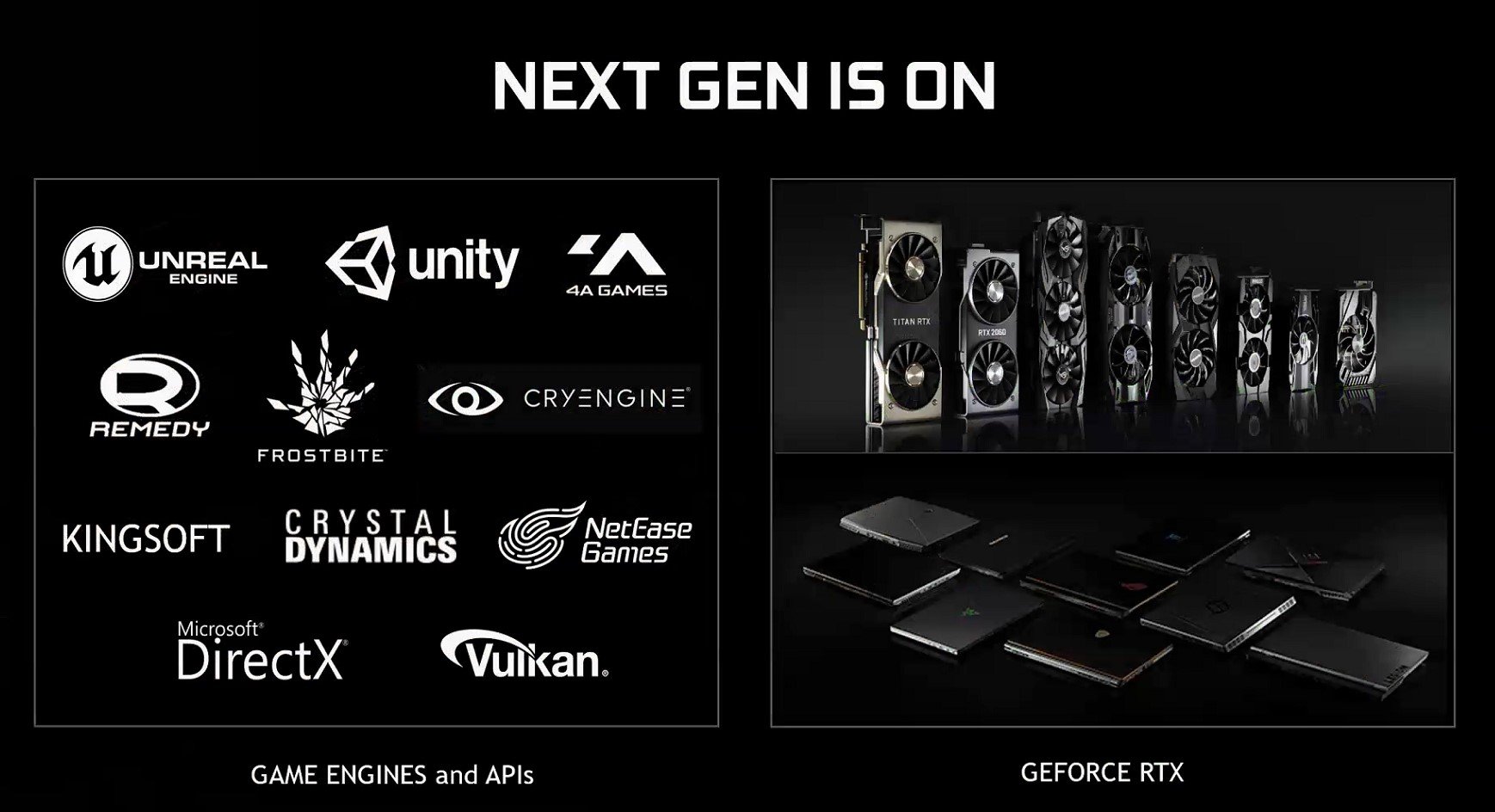The High Definition Render Pipeline (HDRP) includes preview ray tracing support from Unity 2019.3. Ray tracing is a feature that allows you to access data that is not on screen. For example, you can use it to request position data, normal data, or lighting data, and then use this data to compute quantities that are hard to approximate using classic rasterization techniques.
While film production uses ray tracing extensively, its resource intensity has limited its use to offline rendering for a long time. Now, with recent advances in GPU hardware, you can make use of ray tracing effect in real time.
This document covers:
- Unity's NVIDIA PCSS shadows also include NVIDIA Cascaded Shadow Maps and high-quality shadow filtering to further improves the quality of shadowing, and to reduce shadow aliasing. Together, the three technologies greatly improve the realism and fidelity of Unity's world, though understandably some will prefer sharp, unrealistic shadows everywhere, and as such should select the High option in.
- Enable Ray Tracing in Unity with Unity 2019.3 final version by joining me today where I walk you through the entire process of creating a new project with HD.
- Of course, DLSS requires relatively new Nvidia hardware to function (RTX 2000-series or better), so not everyone will see a sudden leap in performance for their Unity games. But if you do have an Nvidia card, 4K gaming with ray tracing on will be the future for quite a few titles.
RTX 3090 RTX 3080 RTX 3070 RTX 3060 HDMI 2.1 Bitcoin Mining Battlefield 6 Fallout 76 2021 Video Cards NVIDIA DLSS tech coming to Unity Engine before the end of 2021.
- Hardware requirements.
- Integrate ray tracing into your HDRP Project.
- HDRP effects that use ray tracing.
Hardware requirements
Install mac os for pc. Ray tracing hardware acceleration is only available on certain graphics cards. The graphics cards with full support are:
- NVIDIA Volta (Titan X)
- NVIDIA Turing (2060, 2070, 2080, and their TI variants)
NVIDIA also provides a ray tracing fallback for some previous generation graphics cards:
- NVIDIA Pascal (1060, 1070, 1080 and their TI variants)
If your computer has one of these graphics cards, it can run ray tracing in Unity.
Before you open Unity, make sure to update your NVIDIA drivers to the latest version, and also make sure your Windows version is at least 1809.
Integrating ray tracing into your HDRP Project
Before you use ray tracing features in your HDRP Project, you need to set up your HDRP Project for ray tracing support. HDRP only supports ray tracing using the DirectX 12 API, so ray tracing only works in the Unity Editor or the Windows Unity Player when they render with DirectX 12. You need to change the default graphics API of your HDRP project from DirectX 11 to DirectX 12.
There are two ways to do this:
Once you have completed one of these, move onto Final setup.
Render Pipeline Wizard setup
You can use the Render Pipeline Wizard to set up ray tracing in your HDRP Project.
- To open the Render Pipeline Wizard, go to Window > Render Pipeline and select HD Render Pipeline Wizard.
- Select the HDRP + DXR tab.
- Click the Fix All button.
Your HDRP Project now supports ray tracing. For information on how to set up ray tracing for your Scene, see final setup.
Manual setup
To set up ray tracing manually, you need to:
- Make your HDRP project use DirectX 12.
- Disable static batching on your HDRP project.
- Enable and configure ray tracing in your HDRP Asset.
- Ensure ray tracing resources are properly assigned.
- Make sure you have a local HDRP-config package that enables ray tracing.
- Enable Screen Space Shadows and Screen Space Reflections in your HDRP Asset.
Upgrading to DirectX 12
- Open the Project Settings window (menu: Edit > Project Settings), then select the Player tab.
- Select the Other Settings fold-out, and in the Rendering section, disable Auto Graphics API for Windows. This exposes the Graphics APIs for Windows section.
- In the Graphics APIs for Windows section, click the plus (+) button and select Direct3d12.
- Unity uses Direct3d11 by default. To make Unity use Direct3d12, move Direct3d12 (Experimental) to the top of the list.
- Apply your changes.
The Unity Editor window should now include the
Disabling static batching
Next, you need to disable static batching, because HDRP does not support this feature with ray tracing in Play Mode. To do this:

- Open the Project Settings window (menu: Edit > Project Settings), then select the Player tab.
- Select the Other Settings fold-out, then in the Rendering section, disable Static Batching.
HDRP Asset configuration
Now that Unity is running in DirectX 12, and you have disabled static batching, enable and configure ray tracing in your HDRP Asset. The previous steps configured Unity to support ray tracing; the following step enables it in your HDRP Unity Project.
- Click on your HDRP Asset in the Project window to view it in the Inspector.
- In the Rendering section, enable Realtime Ray Tracing. This triggers a recompilation, which makes ray tracing available in your HDRP Project.
- You can now configure ray tracing to suit your application. Click the Ray Tracing Tier drop-down and select the tier that matches your use case. See the table below for information on what each tier supports.
| Tier | Description |
|---|---|
| Tier 1 | Balances performance with quality. Use this tier for games and other high-frame rate applications. This tier does not support multiple bounces for lighting effects and you can only use non-recursive effects. |
| Tier 2 | A ray tracing implementation that is significantly more resource-intensive than Tier 1. This tier allows for effects with higher image quality, supports multiple bounces for lighting effects, and supports recursive effects. It also enables the path tracer. The path tracer casts rays from the Camera and traces them until they hit a reflective or refractive surface. It then changes the ray's direction according to the surface's properties and then recurses the process until the ray reaches a light source. The series of rays from the Camera to the Light forms a 'path'. This is the most resource intensive ray tracing method in HDRP. Use this tier for automotive, production, or graphics demos. |
Ray tracing resources
To verify that HDRP has properly assigned ray tracing resources:
- Open the Project Settings window (menu: Edit > Project Settings), then select the HDRP Default Settings tab.
- Make sure there is a Render Pipeline Resources Asset assigned to the Render Pipeline Resources field.
Local HDRP config and ShaderConfig macro validation
The High Definition Render Pipeline (HDRP) uses a separate package to control the availability of some of its features. You can use it to configure certain settings in HDRP without changing the HDRP package itself. First, create a local copy of this package in your Project and change the manifest.json file to point to it. For information on how to do this, see the HDRP Config documentation. Then, to enable ray tracing in HDRP, change the value of a macro in the ShaderConfig.cs.hlsl file.
Open Packages > High Definition RP Config > Runtime > ShaderConfig.cs.hlsl and set the SHADEROPTIONS_RAYTRACING macro to 1.
Unity Rtx
Enable Screen Space Shadows and Screen Space Reflections in your HDRP Asset
HDRP uses ray tracing to replace certain rasterized effects. In order to use a ray tracing effect in your Project, you must first enable the rasterized version of the effect. The two effects that require you to modify your HDRP Asset Screen Space Shadows and Screen Space Reflections. The following step enables them in your HDRP Unity Project.
- Click on your HDRP Asset in the Project window to view it in the Inspector.
- Go to Lighting > Reflections and enable Screen Space Reflection.
- Go to Lighting > Reflections and enable Screen Space Shadows.
- Set the value for Maximum to be the maximum number of screen space shadows you want to evaluate each frame. If there are more than this number of Lights in your Scene, HDRP only ray casts shadows for this number of them, then uses a shadow map for the rest.
Your HDRP Project now fully supports ray tracing. For information on how to set up ray tracing for your Scene, see final setup.
Final setup

Now that your HDRP Project supports ray tracing, there are a few steps you must complete in order to actually use it in your Scene.
Frame Settings
To make HDRP calculates ray tracing effects for Cameras in your Scene, make sure your Cameras use Frame Settings that have ray tracing enabled. You can enable ray tracing for all Cameras by default, or you can enable ray tracing for specific Cameras in your Scene.

To enable ray tracing by default:
- Open the Project Settings window (menu: Edit > Project Settings), then select the HDRP Default Settings tab.
- Select Camera from the Default Frame Settings For drop-down.
- In the Rendering section, enable Ray Tracing.
To enable ray tracing for a specific Camera:
- Click on the Camera in the Scene or Hierarchy to view it in the Inspector.
- In the General section, enable Custom Frame Settings. This exposes Frame Settings just for this Camera.
- in the Rendering section, enable Ray Tracing.
Ray tracing effects overview
HDRP uses ray tracing to replace some of its screen space effects, shadowing techniques, and Mesh rendering techniques.
- Ray-Traced Ambient Occlusion replaces screen space ambient occlusion with a more accurate, ray-traced, ambient occlusion technique that can use off screen data.
- Ray-Traced Contact Shadows replaces contact shadows with a more accurate, ray-traced, contact shadow technique that can use off screen data.
- Ray-Traced Global Illumination is an alternative to Light Probes and lightmaps in HDRP. It includes a different set of properties for Tier 1 and Tier 2 ray tracing.
- Ray-Traced Reflections is a replacement for screen space reflection that uses a ray-traced reflection technique that can use off-screen data.
- Ray-Traced Shadows replace shadow maps for Directional, Point, and Area Lights.
- Recursive Ray Tracing replaces the rendering pipeline for Meshes. Meshes that use this feature cast refraction and reflection rays recursively.
Ray tracing project
You can find a small ray tracing project that contains all the effects mention above here:https://github.com/Unity-Technologies/SmallOfficeRayTracingThis Project is already set up with ray tracing support.
Advice and supported feature of preview ray tracing
DX12 and DXR are currently in preview and are thus missing some functionnality. When you enable DX12, Unity shows this error message:d3d12: generating mipmaps for array textures is not yet supported.
There is no support for ray tracing on other platform than DX12 for now.
HDRP ray tracing in Unity 2019.3 has the following limitations:
- Does not support deformers (skin, vertex animation).
- Does not support VFX and Terrain.
- Does not support several of HDRP's Materials. This includes Hair, StackLit, Eye, and AxF Materials.
- Does not have correct culling for shadows. It uses frustum culling instead.
レイトレーシングは、リアルなライトの挙動と物理マテリアルとの相互作用をシミュレートすることで、写実的なものから様式化されたものまで、あらゆるプロジェクトに本物のグローバルイルミネーションやその他のエフェクトを作成できます。
リアリティとイリュージョン
Unity でリアルタイムでレンダリングされたこのデモでは、実際の自動車と、Unity と NVIDIA を利用して作成された自動車を紹介しています。ずらりと並んだまぶしいライトと高度に忠実なビジュアルによって、互いに見分けがつかなくなっています。
Unity と NVIDIA は BMW とコラボレーションして、2019 年の BMW 8 シリーズクーペの宣伝を行いました。
適切な作業に適切なツールを
ライトの実際の動作が模倣されるこのテクノロジにより、クリエイターに重要な利点がもたらされ、開発者はリアルタイムとリアリティの境界線を意識しない制作とダイナミックな変更を行うことができるようになります。

Unity のレイトレーシング機能により、最高レベルのフォトリアリズムと現実感のあるビジュアルが要求されるプロジェクトのために、リフレクションのほかグローバルライティングが正確かつ動的に計算されます。
Unity のリアルタイムレイトレーシングは、シーン内のリアルなライトの挙動と物理オブジェクトやマテリアルとの相互作用をシミュレートします。この技術的な進歩により、写実的な見た目と様式化された見た目のどちらが必要な場合でも、本物のようなグローバルイルミネーション(GI)とアンビエントオクルージョンやその他のエフェクトを表現できます。
HD レンダーパイプライン(HDRP)にはレイトレーシングのサポートとハードウェアアクセラレーションが含まれているため、オブジェクトが画面外にある場合でもすべてのオブジェクトからの反射を考慮できます。ディレクショナルシャドウとエリアシャドウ、GI、リフレクション、透明性の処理などが実装されています。
HDRP パッケージの DX12/DXR API は、エンジニアリング、建築設計、自動車業界のアプリケーションを対象とします。開始するには、GitHub からサンプルオフィスプロジェクトをダウンロードしてください。
HD レンダーパイプラインでは、スクリーンスペースエフェクト、シャドウイング手法、メッシュレンダリング手法のいくつかに代わって、レイトレーシングが使用されます。
- レイトレーシングされたアンビエントオクルージョンがスクリーンスペースアンビエントオクルージョンに置き換わり、オフスクリーンデータを使用できる、より正確かつレイトレーシングされたアンビエントオクルージョン手法が使用されます。
- レイトレーシングされたグローバルイルミネーションは、HDRP のライトプローブやライトマップの代替となるものです。これには、レベル 1 およびレベル 2 のレイトレーシング用のさまざまなセットのプロパティが含まれます。
- レイトレーシングされたリフレクションがスクリーンスペースリフレクションに置き換わり、オフスクリーンデータを使用できる、レイトレーシングされたリフレクション手法が使用されます。
- レイトレーシングされたシャドウが、ディレクショナル、ポイント、エリアの各ライトのシャドウマップに置き換わります。
- 再帰的レンダリングが、メッシュのレンダリングパイプラインに置き換わります。この機能を使用するメッシュは、屈折や反射の光線を再帰的に照射します。
「開発者向けの Unity のプラグアンドプレイリソースと、大小さまざまなブランドでの人気によって、RTX のレイトレーシングはユーザーに存分に活用されるための機能だといえます」
本物かレンダリングか?リアルタイムレイトレーシング | GDC 2019 での Unity の基調講演
リアルタイムによる車と現実の車の見分けがつきますか?リアルタイムレイトレーシングで何が達成できるのかを強調するために、Unity は NVIDIA および BMW グループと共同で、2019 年の BMW 8 シリーズクーペを紹介しました。
Unity ゲームエンジンへのレイトレーシングハードウェアアクセラレーションの活用
この講演では、Unity でサポートされる機能(リフレクション、エリアシャドウなど)にリアルタイムレイトレーシングを統合する動機となった、設計に関わる主な意思決定について説明します。実装の詳細や最適化について詳しく解説します。
Unity で DirectX レイトレーシングの使用を開始する - SIGGRAPH 2019
このビデオでは、アルゴリズムの泥沼にはまることなく、2019.3 Unity ベータ版で導入された実験的なレイトレーシング機能を使用する方法について説明します。
RTXGI によりレイトレーシングされたリアルタイムグローバルイルミネーションの最適化とデプロイ
Unity でリアルタイムグローバルイルミネーションを作成するために NVIDIA RTXGI が活用されました。この講演では、レイトレーシング、新しい Unity の VFX の詳細に関するデモの舞台裏、ライティングとモデリングに関するベストプラクティスを紹介します。
Unity Rtx Software
現実 vs イリュージョン
レイトレーシングのデモの舞台裏を紹介します。Unity でレンダリングされた BMW の CG を、倉庫で撮影した実際の BMW 8 シリーズクーペと重ねることで、リアルタイムエンジンの汎用性が広告制作プロセスにもたらすメリットをお見せします。
レイトレーシングがユーザーにもたらすもの
Unity のレイトレーシング技術により、ユーザーはまるで現実のように感じられるリアルタイム体験を、手ごろな価格のハードウェアで制作できます。プロジェクトにリアルタイムレイトレーシングを活用する方法について説明します。
